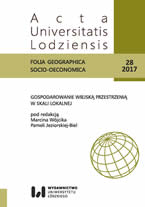Organizacja przestrzenna gruntów w województwie wielkopolskim a możliwości wykorzystania środków UE na jej poprawę na przykładzie wsi Brudzewek
Effects of EU founds on the improvement in the spatial organization of land in Wielkopolska Province by the example of Brudzewek village
Author(s): Ewa Kacprzak, Benicjusz GłębockiSubject(s): Agriculture, Energy and Environmental Studies
Published by: Wydawnictwo Uniwersytetu Łódzkiego
Keywords: Spatial organization of agricultural land; land fragmentation; agricultural land consolidation; Wielkopolska Province;
Summary/Abstract: In the 1990's, and at the beginning of the 21st century, the farm structure in Wielkopolska Province improved in terms of area. At the same time,however, an increase in land fragmentation was noted. The main reason for the unfavorable trend in land pattern observed within the study area was farmland purchasing. Apart from increasing the farm area, land purchases added irregularity to the land pattern, which became increasingly scattered, as purchased land was often located at a considerable distance from the main farm.The scattering of the land pattern can be reduced through land consolidation.Initiatives of this type are supported by the EU funding instruments. A study of the “historical land consolidation” in Brudzewek village, the first EU-funded project of this kind in Wielkopolska, shows that the undertaking is an example of effective use of EU funds. Post-consolidation activities helped to improve the condition of existing infrastructure (roads, land drainage), and expand it.The process of land consolidation in Brudzewek proved to be difuziju to carryout, and affected by a wide array of factors. It showed that the major obstacles in the implementation of similar initiatives were the human factor and the availability of funds.Similarly to other regions of Poland, Wielkopolska requires the launch of large-scale land consolidation projects. Unfortunately, the process entails high costs, and calls for comprehensive solutions for the spatial development of consolidated areas. To be successful, it requires changes to the agricultural policy and its regional diversifikacijom. Also needed are an increase in funding from the state and local governments, and rational use of available EU funding opportunities. Without them, the consolidation process is unlikely to take place on a larger scale.
Journal: Acta Universitatis Lodziensis. Folia Geographica Socio-Oeconomica
- Issue Year: 28/2017
- Issue No: 2
- Page Range: 105-130
- Page Count: 26
- Language: Polish

